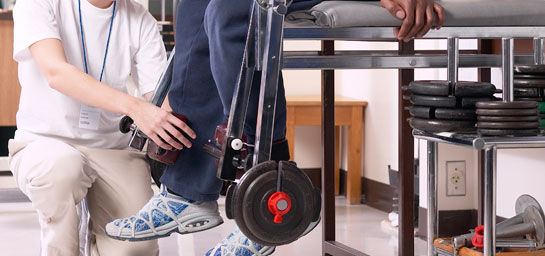
By KELLY JAMES-ENGER
As personal trainers, our primary job is to help clients develop and maintain workout routines that fit their individual needs and lifestyles. To do that, we teach clients how to exercise safely, help them develop self-efficacy, or belief in their own abilities, and help motivate them when their own drive flags.
But what happens when you’re working with someone who’s been injured? These clients may face the opposite problem of someone having trouble sticking to an exercise regime—they want to exercise, but they can’t. Physical pain and limitations are only part of their struggle. Often just as debilitating is the emotional consequence of being unable to pursue their preferred activity of choice. As a fitness professional, you can help clients address this common scenario and turn injury-related “time off” into a new training cycle that will help them maintain their physical and emotional fitness.
Why a Layoff Hurts in More Ways Than One
If you’ve ever been injured, you’ve probably experienced the range of emotions that can occur. According to a 2008 study, the typical emotional responses to athletic injury include tension, anger, depression, frustration and boredom. Frustration and depression are the primary emotional states of athletes post-injury (Walker et al., 2007). A 2009 study published in The Journal of Sport & Exercise found that approximately 10 percent of injured athletes met the standard for major depressive disorder at one month post-injury and 4.4 percent at three months post-injury. Female athletes were more likely to experience depression post-injury than males (Appaneal et al., 2009).
“The four big emotions that come to mind [with a layoff] are frustration, impatience, general irrationality and depression,” agrees sports psychologist Jack J. Lesyk, Ph.D., director of the Center for Sport Psychology in Beachwood, Ohio. Athletes often resist taking time off, even when they need to heal—and Lesyk, a longtime runner, knows this firsthand. “I had Achilles tendonitis and I thought, ‘I’m going to take [only] two days off and let it heal,” he admits. “I wound up not being able to run for six months.”
People who rely on their workouts to release day-to-day stress are particularly vulnerable to anger and tension. “More and more research shows that people who exercise vigorously four or more times a week have a decrease in anxiety, a decrease in depression and an increase in self-esteem,” says Lesyk. “All of those things are going to be somewhat impaired when someone has to suddenly give up exercise.”
Time to Seek Professional Help?

As a fitness professional, you can help clients with the emotional fallout of an injury, but there are some clients who may need professional help, says sports psychologist Jack J. Lesyk, Ph.D., director of the Center for Sport Psychology in Beachwood, Ohio. If you see any of the following behaviors, you might want to consider suggesting that your client may benefit from talking to a therapist or other mental health professional:
- Extremely high levels of frustration and/or anger. Some frustration is normal, but blowing up at you (or admitting to exploding at others) is not.
- High levels of anxiety. Regular exercisers may rely on their workouts to help manage anxiety and stress; losing that outlet may cause additional anxiety that’s difficult to handle.
- Failure to take time off—even under a professional’s recommendation. A client who has a stress fracture in his foot, yet is continuing to log 70-mile weeks may need help accepting the limitations of his injury.
- Significant depression. Symptoms of depression include loss of interest in regular activities, losing or gaining weight, trouble sleeping, sadness and lethargy.
Even a short layoff can produce these kinds of emotions. One study that had female exercisers voluntarily limit their regular aerobic workouts found that the women reported greater fatigue and more negative mood symptoms after just two weeks without their regular exercise (Weinstein et al., 2007). Another study revealed that one of the factors determining the extent of the emotional impact of an injury was the degree to which an athlete identifies with his athletic role (Nippert and Smith, 2008). While most of the studies on the emotional consequences of layoff have been conducted on athletes, there are similar implications for people committed to regular exercise. The more important your client’s fitness or athleticism is to his or her sense of self, the more dramatically he or she may be affected by the injury.
Helping to Heal the Body—and The Mind
The trainer’s role in helping clients at this point is multifaceted. Often one of the first steps is to develop alternate or modified workouts that match your client’s current abilities. “Especially if they’re ‘type A’ personalities, clients will go crazy [being unable to work out],” says ACE-certified Personal Trainer Bryan Lepley, personal training director at Body Business Health Club & Spa in Austin, Texas. “They get depressed at the thought of not being able to work out and that becomes a real challenge.”
Workouts that accommodate the injury can reduce anxiety and depression—and help clients maintain their fitness. For example, “If it’s a lower-limb injury, do upper-body work,” says Lepley. “If it’s a type A person, you’ve got to give him something to do.” Lepley uses the Krankcycle (a piece of cycling equipment that uses arms instead of legs) for injured athletes.
“I have a master’s triathlete and we’ve been able to work on the Crankcycle three hours per week, one hour at a time, and he’s lost none of his fitness level,” he says. “If we can focus on the upper body and maintain people’s level of fitness while they’re overcoming an injury…it keeps them in the game and keeps their minds sharp.”
ACE-certified Personal Trainer and ACE gold–certified Advanced Health and Fitness Specialist Tricia Countie is currently working with a client who just had hip surgery. “We’re doing much more upper-body work and primarily bodyweight exercises with his legs,” says Countie, owner of The IronWorks Personal Trainer Studio in Londonberry, N.H. “The focus is on staying functional and doing movements that are good for him.”
Cooperate With Other Experts
If your client has had surgery or seen a specialist for an injury, make sure you stay in the loop regarding his or her treatment and rehabilitation. “A lot of working with an injured client is actively working with the medical side and dealing with their physical therapist or physician,” says Countie. “We’ll work with them and add in appropriate exercises and make sure that we’re not redundant.”
Keep Your Client Informed
Most injured athletes crave information about their condition—and how they can heal and prevent future injuries. Take a similar approach with your clients, and you’ll help motivate them to stick with their new routine and give them hope for a full recovery. “Coping emotionally is a little bit easier when you have all the facts and you have a timetable,” explains Lesyk. While your clients may not make the same gains they were making from their previous training plans, “you can still [help them reap] a lot of benefits—and something is better than nothing.”
Giving your client an overview of the coming weeks—what types of work you’ll be doing together and why—will help reduce frustration and anxiety. Countie says many of her injured clients are frustrated that they can’t work out or can’t work out the way they’d like to. “Try not to remind your client of what they can’t do,” she says. “You always want to work with what they can do.”
Ask for Regular Feedback
If your client is anxious about getting back to a regular routine, he or she may not want to admit that something hurts. You must constantly ask for feedback. “I’ll tell my client, ‘Let me know what this feels like,’ and ‘I need to know what this feels like tomorrow’,” says Countie. Touching base with clients through phone calls, e-mail, or texts will let you know whether you need to tweak their programs, and keep the lines of communication open.
Build Trust From the Outset
Creating a trusting relationship with your clients from the outset is critical, says Lepley. “If they get injured, you say, ‘Here’s what happened and this is what happens when we get back,” he says. “My clients trust me…they understand that this is part of the game. There are injuries involved in this game we call working out. Hopefully we’ve done a good enough job of keeping them balanced that it doesn’t happen, but, of course, it does happen.”
The better you know your client, the more customized your approach can be. “Every client is different and every client’s needs are different,” says Lepley. “You need to know them well enough to know whether you should create another workout or focus on the nutritional component of their program.”
Part of the client-trainer relationship is being honest about what clients can expect. “With strength training, I’m frank,” says Lepley. “If you’re out for four to six weeks, you’ll lose [a significant] level of fitness. But as long as we’re smart about what you do when we come back, you’re going to gain that back.”
Focus on the Positive
“It’s easy for clients to focus on the negative,” says Countie. “A big thing is getting them to think about the positive…if they take care of it now, what is acute won’t become chronic.” Encourage your clients to look at their post-injury period as a time not to stop, but to slow down or refocus on their programs. “It’s a caretaking, healing period, but that doesn’t mean it becomes a sedentary period,” she says. “There’s always something you can do. Maybe your client can’t do anything plyometric, but this is a time when she can start doing yoga.”
In your role as fitness professional, you have the power to help your clients view an injury not as a roadblock, but as an opportunity to work on other aspects of fitness. Workouts that match a client’s current abilities, but still provide a challenge, will help give a feeling of progress as he or she heals.
___________________________________________________________________

Kelly James-Enger is an ACE-certified Personal Trainer, author and freelance journalist in Downers Grove, Ill.
References
Appaneal, R., Levine, B., Perna, F. and Roh, J. (2009) Measuring post-injury depression among male and female competitive athletes. Journal of Sport and Exercise Psychology, 31, 60–76.
Nippert, A. and Smith, A. (2008). Pyschologic stress related to injury and impact on sport performance. Physical Medicine and Rehabilitation Clinics of North America, 19, 399–418.
Walker, N., Thatcher, J. and Lavallee, D. (2007). Psychological responses to injury in competitive sport: a critical review. Journal of the Royal Society for the Promotion of Health, 127, 4, 174–80.
Weinstein, A, Deuster, P. and Kop, W. (2007). Heart rate variability as a predictor of negative mood symptoms induced by exercise withdrawal. Medicine and Science in Sports and Exercise, 39, 4, 735–741.